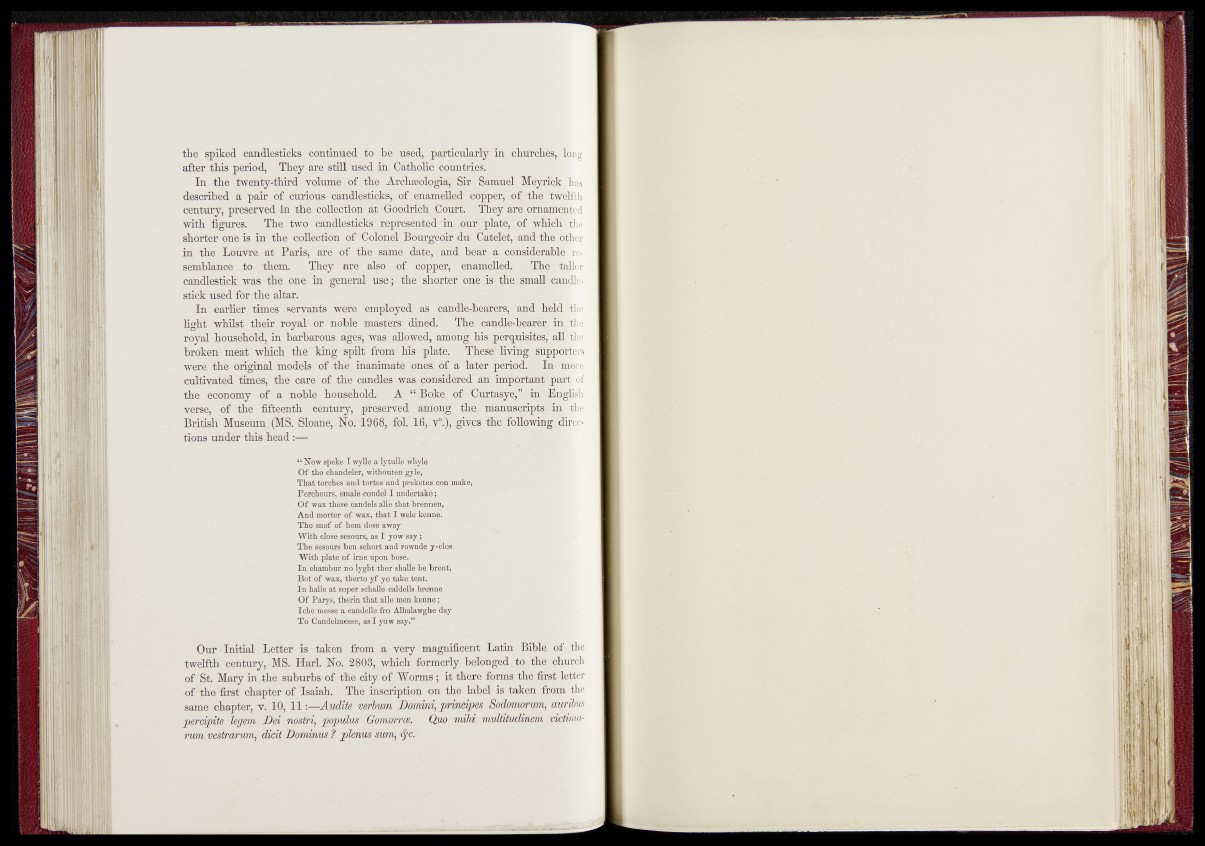
the spiked candlesticks c o n t i i i u g d « u s e d , particularly .in'churches, long
after this period, sHfey are still used in !(p|ktholic 'dophtries'?"
In the "twenty-third Tolume' ofl^iej^Arch^olo^ ^ ^ Sir ^Samuel ^fc\rick ias
described a pair of seuraouS candlesticks, of - enarodned- > ,<$@55pery, of
century, preserved unlthe. collection vat Goodrich* tlpurbf i T{hey are- ornamented
■with figures. The two candlesticks"’ represented in .mjr^platc, of liic h Ihe,
shorter one Is in the hojlectipn of Colonel 'Bourgebjr’du and th ^ other
in the Louvre at Paris,- are o f-th e same' date," and hear' a gensi$.efable resemblance
to jjhem. ^ 'Thejp'bare also ■ ofj&QBireiffi e n a m e l l e d . ; v
eandlesfi(& was-the one in geg$ral yse^^tl^%m)iter Orie'iis^the smaBWwle-
stick- used for the altar.
In earlier tanies -servants were’.miplbyedri-afe candle-bea^ersj“ and* held Ihe
light whilst thqir royal or noble masters' dined. The candle-(bcaijcr in pie
royal household, in barbarous 'ages, was „allowed, among Ihe
broken meat •which the' king spjit from- his--plate: v^IheB(i^lmji‘g<^^^®6it( is
were the original models of'the inanimate, ton<s of a lilter pcrio'd ^®ni'oi |
cultivated time^ &e care of the candles was^nsidered an dviiiortaiit part of
the economy of a noble household. A rt‘Boke/ ufh Gji&taSv&l’ .^M j»?li-11
verse, of the fifteenth ©entury, preserved^ kgidng- the. m|nu9criptsy in pie
British MnseiiTn (MST Sloane* fdllowingfdirections
under this head fgHjl
“ Now speke Iwylle ailytullejwhyle
'Of tho chandeler, witKouten-gyie,’ . “
That torches and tortes and preki'tos con make,
Perishonrs, smale condel 1 undertake;
* Of wax these candelg alle that’b^ennenjr ^
And morter of wax, that I wde-kenne;^^
Tho snof of hom dose away
With close sesonrs, as I yow say;
The sesonrs ben schort and rownde y-clos$}_
With pljte of irne upon bose.
In chambur no lyghtther shalle be brent, -
Bot of wax, therto y f ye take tent.
In halle at soper schalle caldells brenne
Of Parys, therm that alle men kenne;
Iche messe a candelle fro Alhalawghe day
To Candelmesse, as I yow say.”
Our Initial Letter is taken from a very ma,gnificefit Latin Bible of gfche
twelfth century, MS. HarL No. 2803, which formerly belonged to the |hurch
of St. Mary in^fhe suburbs of the city of Worms; it there forms the first letter
of the first chapter of Isaiah. The inscription on the label is taken from Be
same chapter, v. 10, l l :—Audite verbim T)ominirprindpes Sodorriorum, ©h'te
p&rdpite legem D d nostri, populus Oomorrce. Quo mihi multitudinerh mpima-
mm vestrarum, didt Som inust plenus sum, tyc.